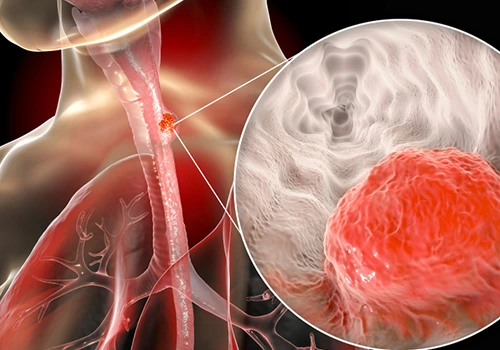What is Esophageal Cancer?
Esophageal cancer is identified by the uncontrolled growth of cells that line the esophagus, a hollow, muscular tube connecting the throat to the stomach. Understanding the natural structure and function of the esophagus is crucial to grasp this condition. In adults, the esophagus is approximately 10-13 inches (25-33 centimeters) in length and 0.75 inches (2 centimeters) in width at its narrowest point, situated behind the windpipe and in front of the spinal column.
The upper esophageal sphincter, a specialized muscular ring, relaxes to allow the passage of food or liquids when detected. Nutrients and fluids swallowed traverse the esophagus to reach the stomach. The lower esophageal sphincter, another specialized muscular ring, regulates the movement of food from the esophagus to the stomach. The wall of the esophagus consists of several layers, with the innermost lining called the epithelium, typically composed of smooth, thin, squamous cells. Between meals, this lower part of the esophagus remains closed to prevent the escape of stomach acid and digestive juices.
Types of Esophageal Cancer
Esophageal cancer has two primary types:
- Squamous Cell Carcinoma: A type of cancer that originates from the thin, flat cells lining the esophagus’s surface. This particular malignancy commonly appears in the upper or middle sections of the esophagus, although it can occur elsewhere in the esophagus but less frequently.
- Adenocarcinoma: A malignancy that begins in the glandular cells of the esophagus responsible for producing mucus-like substances. Adenocarcinoma is predominantly prevalent in the distal or lower portion of the esophagus. Other categories of esophageal cancer are rare in the human body.
Symptoms of Esophageal Cancer
In the early stages of esophageal cancer, there may be a lack of recognizable symptoms; however, as time progresses, treatable symptoms warrant attention. Such signs include the following:
- Stomach burning
- Throat pain or swallowing difficulties
- Digestive problems
- Hoarseness or voice thickening
- Sudden weight loss
- Nausea and vomiting
- Chest pain
- Acid reflux

Causes and Risk Factors for Esophageal Cancer
Esophageal cancer is a malignancy with various risk factors. These factors include excessive alcohol consumption, tobacco, and tobacco product overuse, as well as conditions such as gastroesophageal reflux disease (GERD) and Barrett’s esophagus, which lead to changes in the tissue of the lower esophagus. Additionally, the HPV virus, persistent consumption of very hot liquids, and the natural aging process, which reduces the former resilience of cells, are also associated with an increased risk of developing esophageal cancer.
Methods of Diagnosing Esophageal Cancer
In order to confirm the presence of esophageal cancer, a physician conducts a comprehensive evaluation of the patient’s symptoms and medical history. Additionally, experts utilize a wide range of diagnostic tests, as appropriate, to enhance the accuracy of the diagnosis. These tests include:
- Blood Tests
- X-ray Imaging:
When an individual is suspected to have a malignant tumor in the esophagus, it is crucial to inject a barium solution to ensure that the entire surface of the esophagus is coated. The purpose of this barium administration lies in its fluid nature, which aids in visualizing nearly the entire esophageal surface during X-ray imaging, thereby facilitating the identification and diagnosis of esophageal cancer.
- Endoscopy:
A specialized individual in this particular examination employs an endoscope, a thin tube inserted through the mouth, to assess the extent of the disease and guide towards the tissues adjacent to the esophagus.
- Biopsy:
In the hands of a physician, suspected biological materials are retrieved for analysis in a controlled laboratory environment. The resulting report, generated by the pathology team, serves to confirm or rule out the presence of malignant cells in the sample.
- CT Scan
- PET Scan:
In this method, radiotracers, which are radioactive substances, are used to detect changes in the metabolic activity of body tissues.

- Laparoscopy:
Laparoscopy is a surgical procedure that utilizes an endoscope, a thin tube-like instrument with light and a camera, to examine or address organs located in the abdomen and pelvis. This examination and removal of internal organs are facilitated using a limited number of small incisions.
Additionally, during the laparoscopy process, physicians can obtain samples for biopsy methods. Laparoscopy is utilized for precise staging of esophageal cancer and enables the physician to formulate a treatment plan.
The Different Stages of Esophageal Cancer Progression
The progression of esophageal cancer is classified into stages using a numerical system, ranging from stage one, which represents early-stage cancer, to stage four, which signifies advanced cancer. This system aids the medical team in selecting the most effective treatment for the patient.
- Stage one indicates the presence of abnormal and cancerous cells,
- stage two shows that cancer cells have spread to the muscular part of the esophagus and potentially cause damage to adjacent cells.
- When cancer cells infiltrate the esophageal wall and muscle and potentially harm nearby lymph nodes and surrounding areas, it is classified as stage three.
- Finally, the most dangerous and extensive stage, known as metastatic, is categorized as stage four.
Treatment Methods for Esophageal Cancer
- Surgery: Surgery can be used independently or in combination with other treatment methods to eliminate cancer cells. In cases where cancer cells are limited and localized to the outermost layers of the esophagus and have not metastasized, surgery may involve the removal of cancerous cells. Early-stage esophageal cancer can sometimes be treated using endoscopy, which is introduced through the patient’s throat into the esophagus.
Additionally, partial removal of the esophagus and nearby lymph nodes and the upper part of the stomach can be performed using another surgical approach.
- Radiation Therapy: Radiation therapy can be employed to eradicate cancerous tissue using high-energy waves or a specific type of energy to prevent the growth and division of cancer cells. This method leads to the gradual contraction of cells and eventual destruction. The primary goal of radiation therapy is to minimize damage to healthy cells during the elimination of cancer cells, although it may occasionally affect adjacent healthy cells or prevent their growth and division by damaging their DNA.
- Chemotherapy: Chemotherapy is a drug-based intervention that utilizes chemical substances to eradicate malignant cells. It can also be used in conjunction with radiation therapy and surgical methods.

- Targeted Therapy: Targeted therapy uses drugs that specifically target particular molecules, especially proteins present in cancer cells. The primary goal of this treatment is to prevent or halt the malignant growth by targeting genetic features that contribute to cell division and growth.
- Immunotherapy: This approach enhances the body’s immune system’s ability to combat malignant cells.
Preventive Measures to Reduce the Risk of Esophageal Cancer
The following preventive actions can help reduce the risk of developing esophageal cancer:
- Avoiding tobacco and alcohol consumption
- Regular exercise and walking
- Maintaining a balanced weight and avoiding obesity
- Paying attention to and treating gastro-esophageal reflux disease (GERD)
Last Words
Esophageal cancer demands our attention and understanding. With its subtle onset and potentially severe consequences, early detection and consultation with a specialist are crucial.
Dr. Maadico is here to guide you through every step.
Take Control of Your Esophageal Health! Schedule a Consultation with Dr. Maadico Today!
Get a Free Consultation
Frequently Asked Questions
- Is esophageal cancer an inherited disease?
The likelihood of inheriting esophageal cancer is low, but members of a family can undergo genetic testing to assess their carrier status for specific hereditary mutations.
- What role does nutrition play in the development of esophageal cancer?
Research suggests that processed foods such as snacks, sodas, ready-made meals, processed meats, and excessive alcohol consumption can increase the risk of developing esophageal cancer.
- What are the symptoms of esophageal cancer?
- Difficulty swallowing
- Sensation of pain or burning in the chest
- Weight loss
- Hoarseness
- Vomiting
- Bleeding into the esophagus (this blood passes through the digestive system, causing dark and tarry stools)

- How long is the hospital stay for esophageal cancer surgery?
On average, the hospitalization period for a patient undergoing esophageal cancer surgery ranges from 9 to 14 days.
- What is the post-operative care following esophageal cancer surgery?
- Usually, following surgery and upon regaining consciousness, the patient is confronted with a nasal tube through which they receive necessary medications. Patient nutrition is also administered through another tube.
- As the patient’s condition gradually improves, the possibility of them drinking fluids becomes available. Initially, they should consume only thin fluids, and gradually, over the course of two weeks, the patient can also consume thicker fluids. These fluids include water, meat or chicken broths, very lightly colored tea, low-fat milk, and diluted fruit juices.
- In the second phase, and based on the physician’s recommendation, the patient can begin to introduce semi-solid foods or purees into their diet.
- It is worth noting that refraining from smoking, hookah use, and consuming carbonated beverages is imperative.
- Another post-operative care measure is to monitor for signs of blood clot formation, known as deep vein thrombosis (DVT). If the patient or their caregivers notice swelling, redness, or a sensation of warmth in the patient’s leg, they should immediately inform the physician to prevent blood clot movement and embolism.


